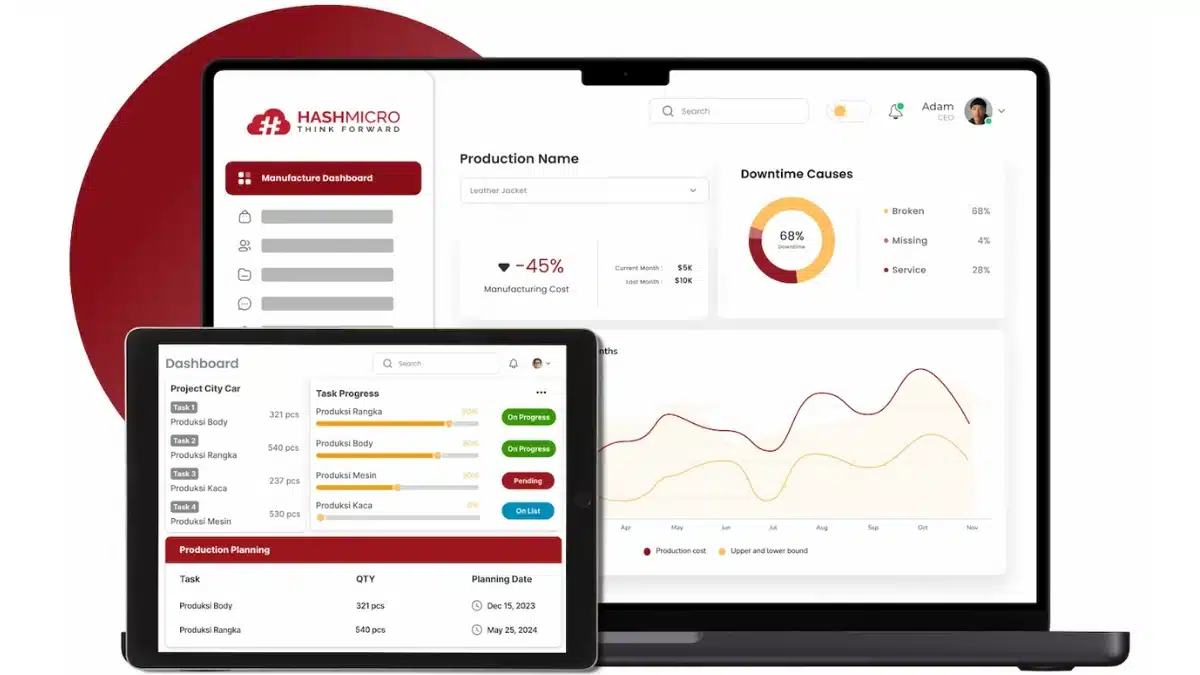Every shift on the factory floor, some materials end up as scrap. Maybe from defects, maybe from machines running slightly off calibration. At first, the numbers look small, a few bad parts here and there, nothing that sets off alarms.
But scrap has a way of adding up quietly. By the end of a week or a month, those small rejects can snowball into thousands of wasted units. The real cost isn’t just in materials lost. It’s in extra labor, rework, and delayed schedules that eat into margins.
That’s why scrap rate matters. It tells you exactly how much of your output becomes waste and why. For manufacturers, understanding this figure is the first step toward controlling costs, tightening processes, and building a production system that truly runs efficiently.
Try our free demo and keep reading to find out more about the scrap rate!
Key Takeaways
|
What is Scrap Rate?
Scrap rate is a key metric used to measure the proportion of materials or components that are discarded during manufacturing, construction, or maintenance activities. It reflects waste from processes such as production, repairs, or renovations, and is calculated by dividing the amount of scrap generated within a specific period by the total output produced.
A high scrap rate often signals inefficiencies in material quality, production methods, KPI achievement, or project management. In contrast, a low scrap rate suggests effective resource use, minimal waste, and more substantial recycling efforts, all of which contribute to sustainability.
What is Scrap Rate Calculation?
Scrap rate measures the portion of products that turn into waste due to defects or mistakes in the manufacturing process. It may also include items that are reworked for different uses but no longer serve their intended purpose.
To calculate it, the amount of scrap generated during a given period is divided by the total number of finished items. The result, expressed as a percentage, shows how many goods are considered unusable.
Here’s the formula:
Importance of Calculating Scrap Rate
Knowing your scrap rate is important because it reveals more than just wasted materials. It shows where money, time, and resources are slipping away, and where improvements can be made.
- Cost control: High scrap rates push production costs up by wasting materials and resources.
- Process improvement: Looking into why scrap occurs can highlight weak spots in production and open the door to better efficiency and quality.
- Environmental impact: Cutting down on scrap also means less waste and lower demand for raw materials, easing the environmental burden.
Scrap rate analysis also connects directly to several key areas of manufacturing:
- Resource allocation: It shows whether resources are being used effectively, guiding decisions on where to add or shift support.
- Quality assurance: It indicates how well quality control procedures are working and whether adjustments are needed.
- Material use: It reflects how efficiently raw materials are prepared and consumed in production.
- Equipment performance: It highlights machines or processes that require maintenance, modification, or replacement.
- Cost assessment: It helps evaluate budgets by linking waste levels with overall production costs.
Ultimately, scrap rate isn’t just about numbers. It’s a practical tool that helps companies cut costs, maintain quality, and operate more sustainably.
What Causes High Scrap Rate?
A high scrap rate often signals deeper issues in the production process. These problems may come from materials, machines, people, or procedures.
1. Low-Quality Raw Materials
When inputs are substandard, defects in the final product are almost unavoidable. Metals with impurities, plastics with uneven density, or fabrics with visible flaws can all generate scrap. Even minor irregularities become costly when scaled across large production runs.
2. Equipment Malfunctions or Inefficiencies
Poorly maintained or miscalibrated machines can cause dimensional errors, rough finishes, or incorrect assembly. Outdated equipment that struggles to meet modern precision standards also raises the risk of unusable output.
3. Operational Errors
Human mistakes on the factory floor, such as wrong machine settings, improper material handling, or skipped procedures, can produce unnecessary waste. These errors tend to increase in high-pressure environments where speed is prioritized over accuracy.
4. Outdated or Inconsistent Procedures
Production methods that are not updated with new standards or technologies often lead to inefficiencies. The introduction of new equipment without adequate training or integration can further increase mistakes, resulting in more scrap.
A combination of these factors can worsen the problem. For instance, poor-quality materials put more strain on equipment, while outdated procedures make human errors harder to detect. Together, they contribute to a higher-than-expected scrap rate and greater production losses.
What is an Acceptable Scrap Rate?
The acceptable scrap rate depends on the industry, the type of material, and how critical the end product is. In high-precision sectors like aerospace or electronics, even a small percentage of waste can be unacceptable.
Meanwhile, industries working with lower-cost materials, such as plastics, may allow for slightly higher levels of scrap.
As a general guideline, many manufacturers aim for a scrap rate of below 5%. Anything consistently above that often signals issues in raw materials, equipment performance, or production methods.
Still, the definition of “acceptable” should always factor in the cost and importance of the material being used.
| Industry / Material | Typical Acceptable Scrap Rate | Notes |
|---|---|---|
| Automotive / Aerospace | 0.5–1% | Safety and precision standards demand minimal scrap. |
| Electronics | <1% | Even small scrap levels can be costly due to expensive components. |
| Metal Fabrication | 2–5% | Higher tolerance, though costly alloys may lower the threshold. |
| Plastic Injection Molding | 2–5% | Generally acceptable, especially when working with cheaper resins. |
| Construction Materials | 3–7% | Larger tolerances allowed, depending on project scope and material value. |
How to Calculate Scrap Rate
Here’s an example of how to calculate scrap rate.
1. Determine the number of scrap items
Record the total number of defective or wasted items during production. For example, a company reviews its bill of materials and finds 200,000 scrap items.
2. Find the total number of completed items
Calculate the total yield that passes quality control and is ready for use or sale. In this example, the company completed 1,500,000 items.
3. Apply the formula
Substitute the values into the formula:
This result means that 13% of the company’s total production ended up as scrap.
How HashMicro Helps Manufacturers Control Scrap Rate
On the shop floor, scrap is part of the job, but when it starts piling up, it eats into margins and clogs schedules. Whether it’s bad raw stock, machines drifting out of calibration, or operators running with outdated settings, every bit of waste adds up.
With HashMicro Manufacturing Software, you don’t have to wait until month-end reports to know how much you’ve lost. The system logs scrap as it happens, giving managers a clear picture of where it’s coming from and how big the impact really is.
Instead of chasing spreadsheets or relying on guesswork, production teams can see the numbers in real time and act before problems snowball. That means fewer surprises, tighter control over materials, and better use of manpower; all based on actual data from the floor.
- Material Tracking: Catch bad raw stock early. The system records rejects from suppliers before they reach the line, so defects don’t spread through production.
- Production Planning: Keep schedules realistic. Machines aren’t overloaded, operators aren’t rushed, and the result is fewer errors that turn into scrap.
- Quality Control Checks: Record rejects right at the line, not after the whole batch is finished. Problems show up immediately instead of piling up downstream.
- Maintenance Scheduling: Plan service for machines that drift out of spec or need recalibration. This reduces scrap caused by misaligned or worn-out equipment.
- Batch & Lot Traceability: When defects happen, trace them back to the exact supplier, shift, or machine. That makes root-cause fixes faster and more precise.
- Scrap Reporting: Daily scrap data is turned into clear numbers: percentages, process breakdowns, and cost impact; so managers see exactly how waste affects production.
Conclusion
Scrap rate shows how much waste a company produces, highlighting inefficiencies, costs, and environmental concerns. Understanding and tracking this metric helps businesses improve resource use, product quality, and overall production efficiency.
With HashMicro Manufacturing Software, managers gain real-time visibility into scrap, enabling faster responses and smarter resource allocation. The system turns raw data into actionable insights, helping manufacturers reduce waste while keeping operations consistent and profitable.
Instead of guessing or chasing spreadsheets, production teams use HashMicro to manage scrap directly from the shop floor. This gives companies tighter control, stronger quality assurance, and confidence their manufacturing process runs with maximum efficiency.
Book a free demo today and see the difference firsthand!

FAQ on Scrap and Waste in Malaysia
-
Are there new import rules for plastic scrap in Malaysia?
Yes — from 1 July 2025, all plastic scrap imports must be approved by SIRIM and comply with stricter contamination, origin, and homogeneity rules.
-
Does Malaysia require pre-inspection for metal scrap imports?
A proposal from SIRIM suggests all metal scrap imports be subject to preshipment inspection and bans on low-grade or “crushed” scrap forms.
-
Can companies get duty exemptions when exporting scrap from Malaysia?
Generally no — Malaysia does not allow export duty exemptions for manufacturing waste or scrap.
-
What licensing is needed for steel & iron scrap trade in Malaysia?
Companies trading or manufacturing iron & steel products must hold appropriate licenses (e.g. from MITI) and may need approval or permits to handle scrap trade.





























